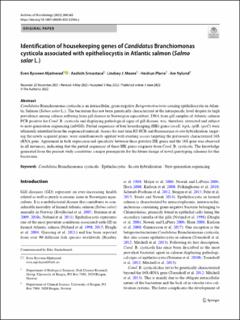| dc.contributor.author | Mjølnerød, Even Bysveen | |
| dc.contributor.author | Srivastava, Aashish | |
| dc.contributor.author | Moore, Lindsey | |
| dc.contributor.author | Plarre, Heidrun | |
| dc.contributor.author | Nylund, Are | |
| dc.date.accessioned | 2022-12-08T12:12:52Z | |
| dc.date.available | 2022-12-08T12:12:52Z | |
| dc.date.created | 2022-09-12T08:36:56Z | |
| dc.date.issued | 2022 | |
| dc.identifier.issn | 0302-8933 | |
| dc.identifier.uri | https://hdl.handle.net/11250/3036771 | |
| dc.description.abstract | Candidatus Branchiomonas cysticola is an intracellular, gram-negative Betaproteobacteria causing epitheliocystis in Atlantic Salmon (Salmo salar L.). The bacterium has not been genetically characterized at the intraspecific level despite its high prevalence among salmon suffering from gill disease in Norwegian aquaculture. DNA from gill samples of Atlantic salmon PCR positive for Cand. B. cysticola and displaying pathological signs of gill disease, was, therefore, extracted and subject to next-generation sequencing (mNGS). Partial sequences of four housekeeping (HK) genes (aceE, lepA, rplB, rpoC) were ultimately identified from the sequenced material. Assays for real-time RT-PCR and fluorescence in-situ hybridization, targeting the newly acquired genes, were simultaneously applied with existing assays targeting the previously characterized 16S rRNA gene. Agreement in both expression and specificity between these putative HK genes and the 16S gene was observed in all instances, indicating that the partial sequences of these HK genes originate from Cand. B. cysticola. The knowledge generated from the present study constitutes a major prerequisite for the future design of novel genotyping schemes for this bacterium. | en_US |
| dc.language.iso | eng | en_US |
| dc.publisher | Springer | en_US |
| dc.rights | Navngivelse 4.0 Internasjonal | * |
| dc.rights.uri | http://creativecommons.org/licenses/by/4.0/deed.no | * |
| dc.title | Identification of housekeeping genes of Candidatus Branchiomonas cysticola associated with epitheliocystis in Atlantic salmon (Salmo salar L.) | en_US |
| dc.type | Journal article | en_US |
| dc.type | Peer reviewed | en_US |
| dc.description.version | publishedVersion | en_US |
| dc.rights.holder | Copyright 2022 the authors | en_US |
| dc.source.articlenumber | 365 | en_US |
| cristin.ispublished | true | |
| cristin.fulltext | original | |
| cristin.qualitycode | 1 | |
| dc.identifier.doi | 10.1007/s00203-022-02966-y | |
| dc.identifier.cristin | 2050552 | |
| dc.source.journal | Archives of Microbiology | en_US |
| dc.identifier.citation | Archives of Microbiology. 2022, 204 (7), 365. | en_US |
| dc.source.volume | 204 | en_US |
| dc.source.issue | 7 | en_US |

